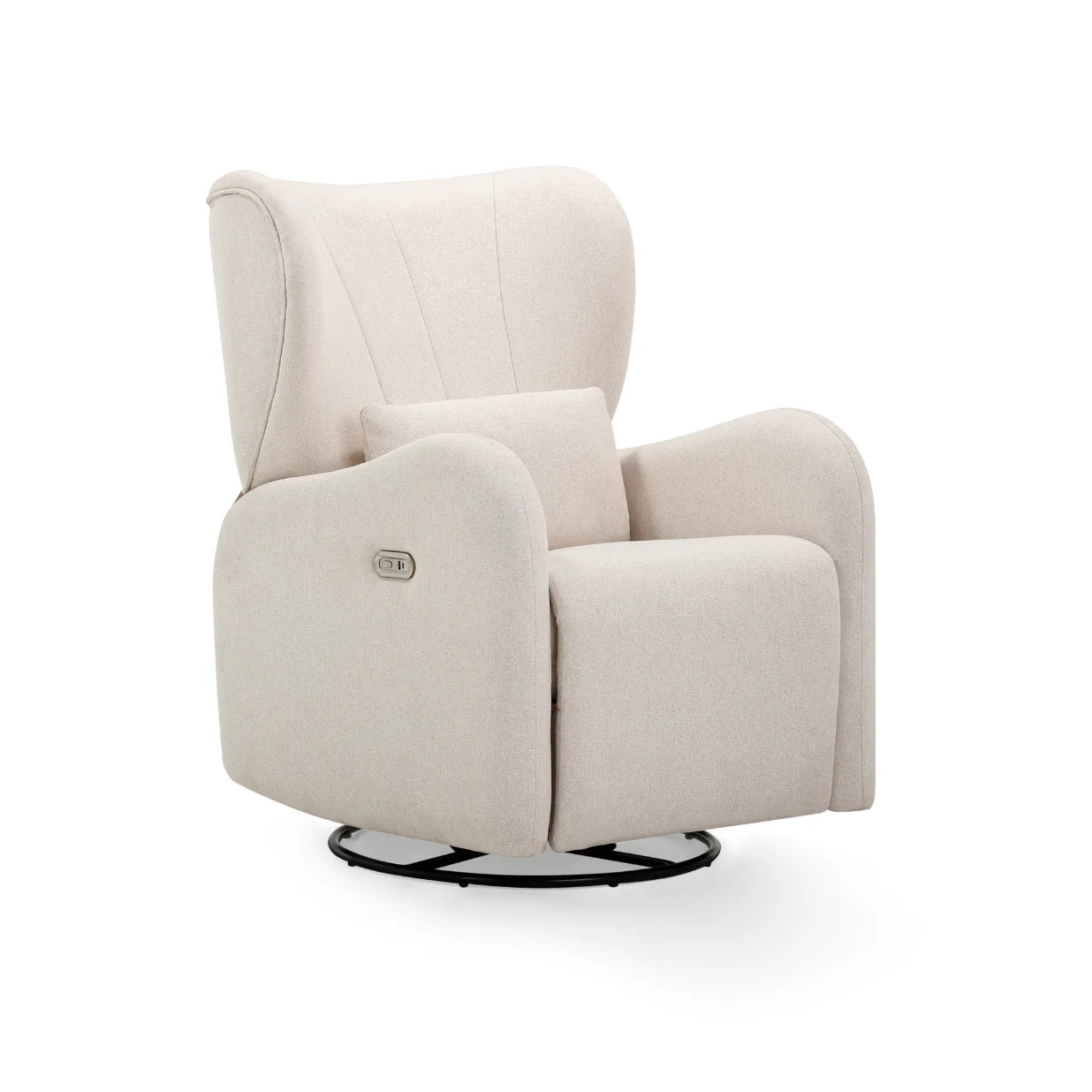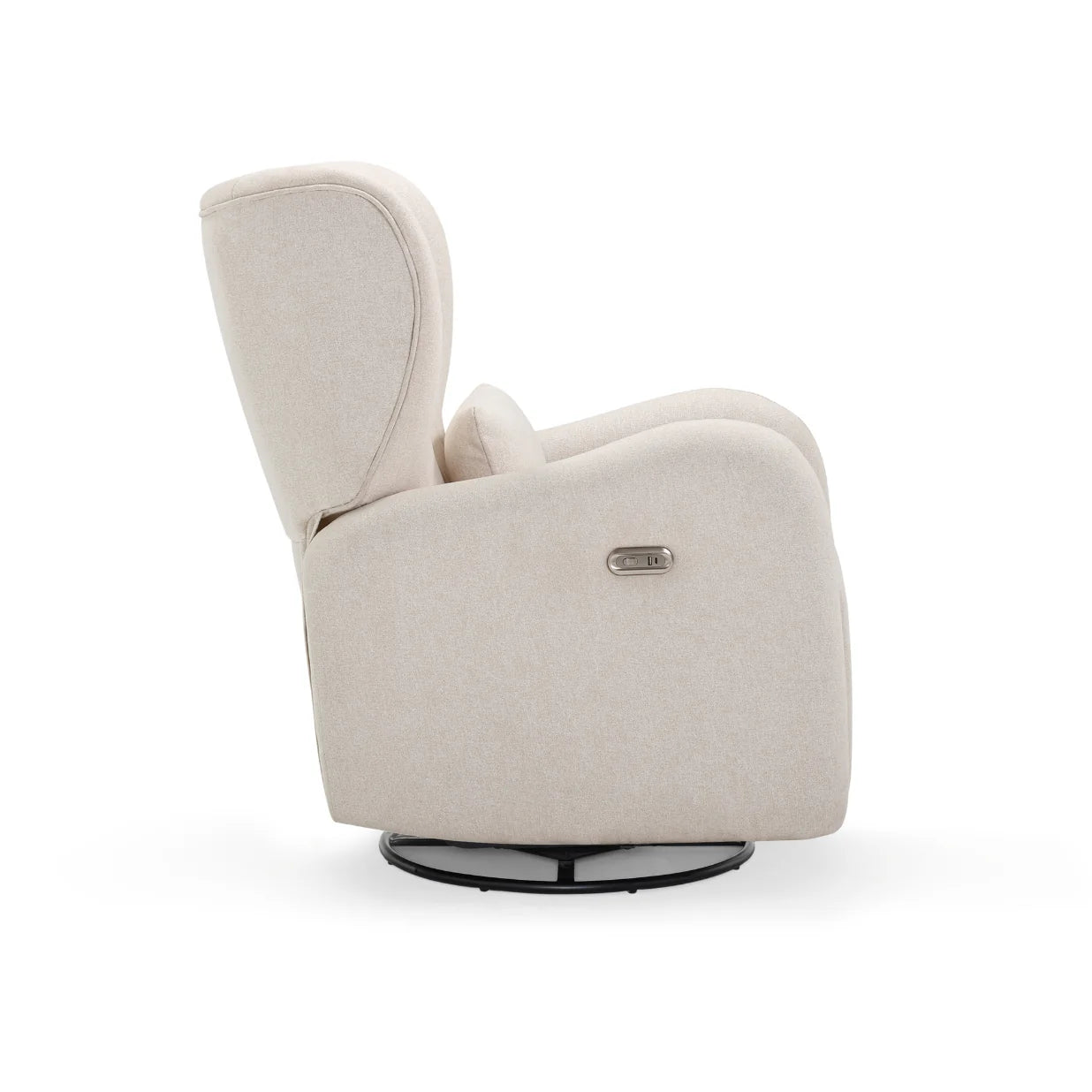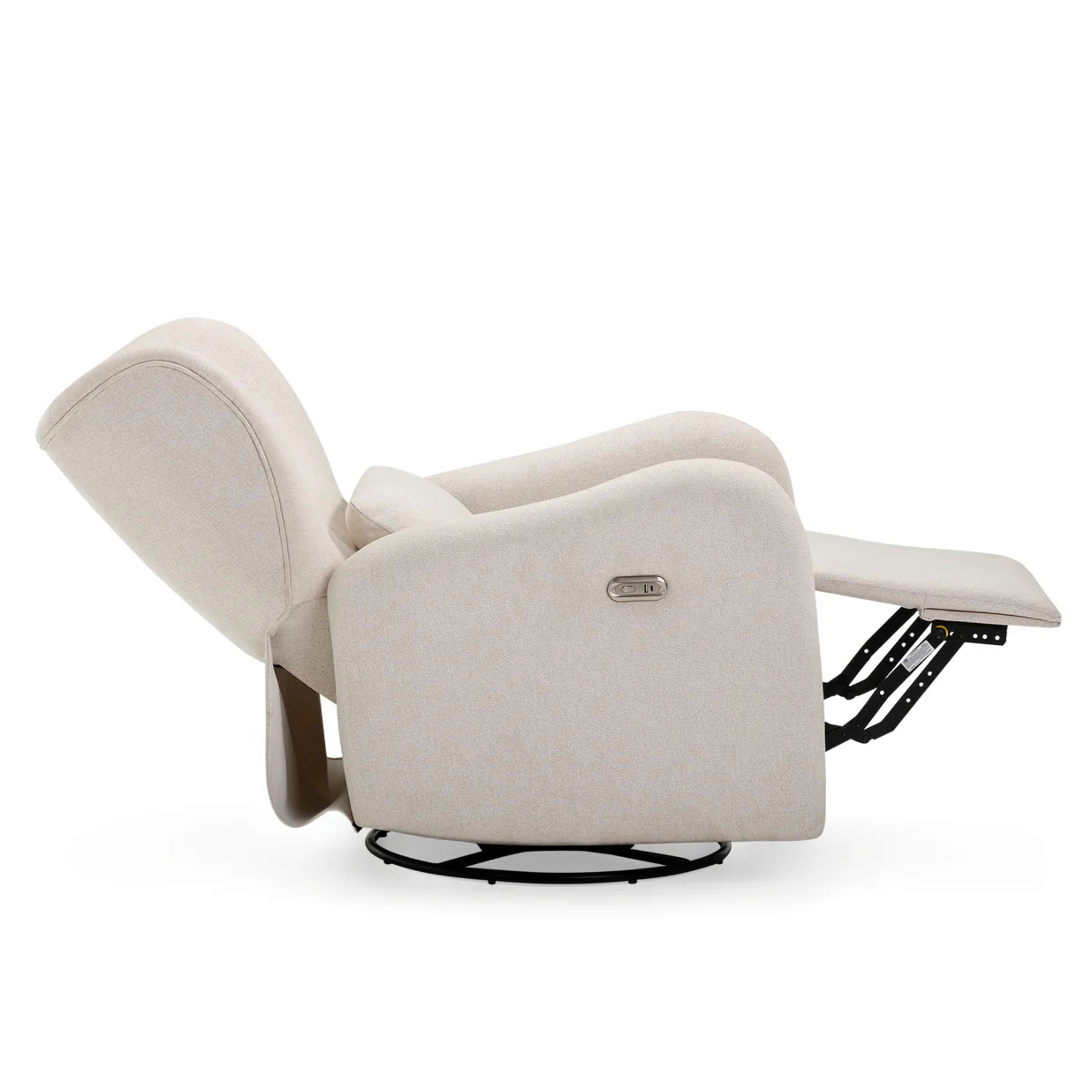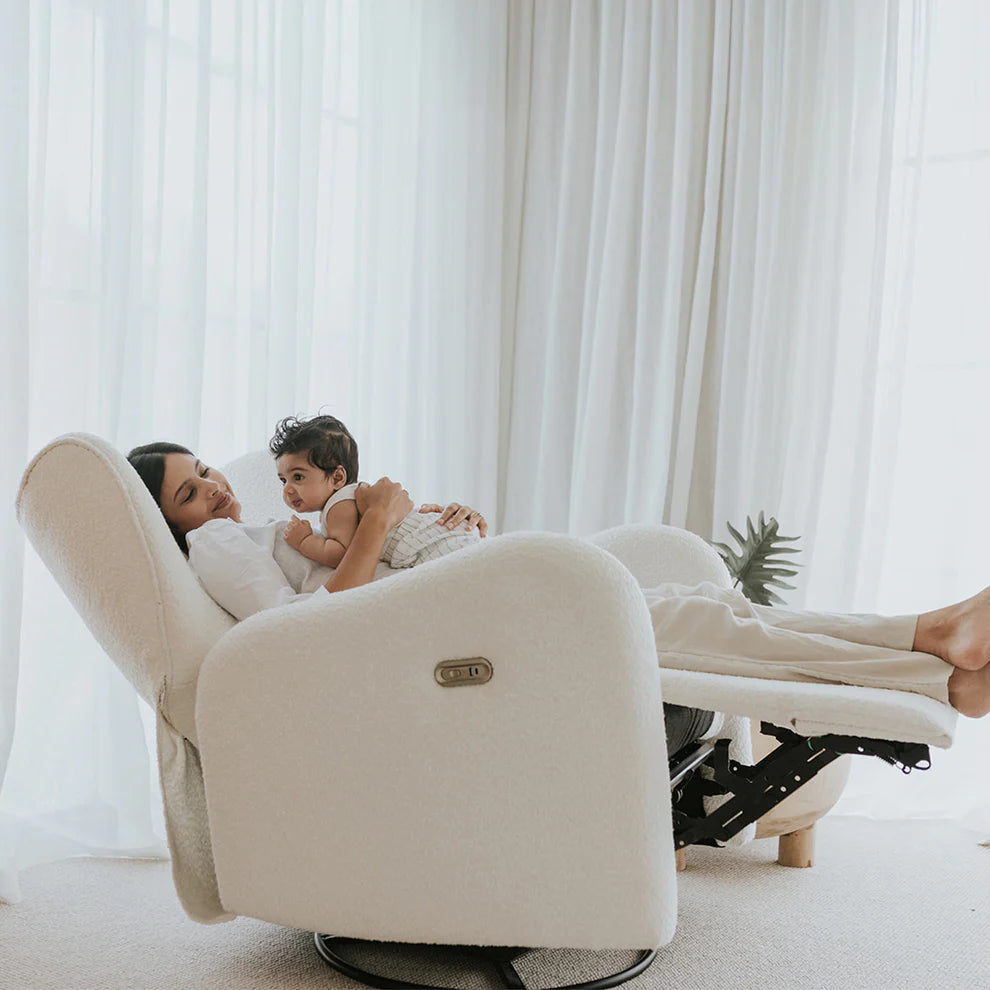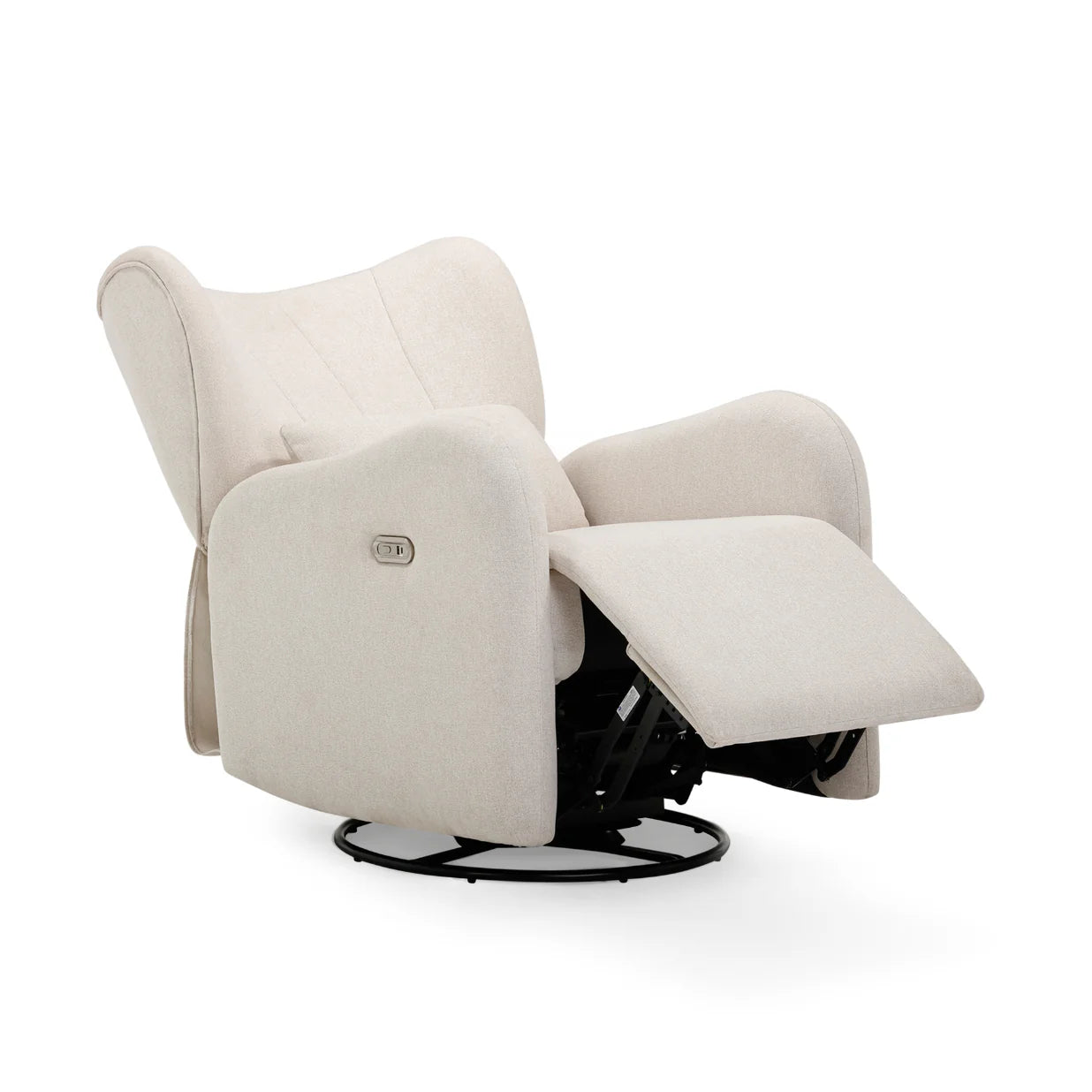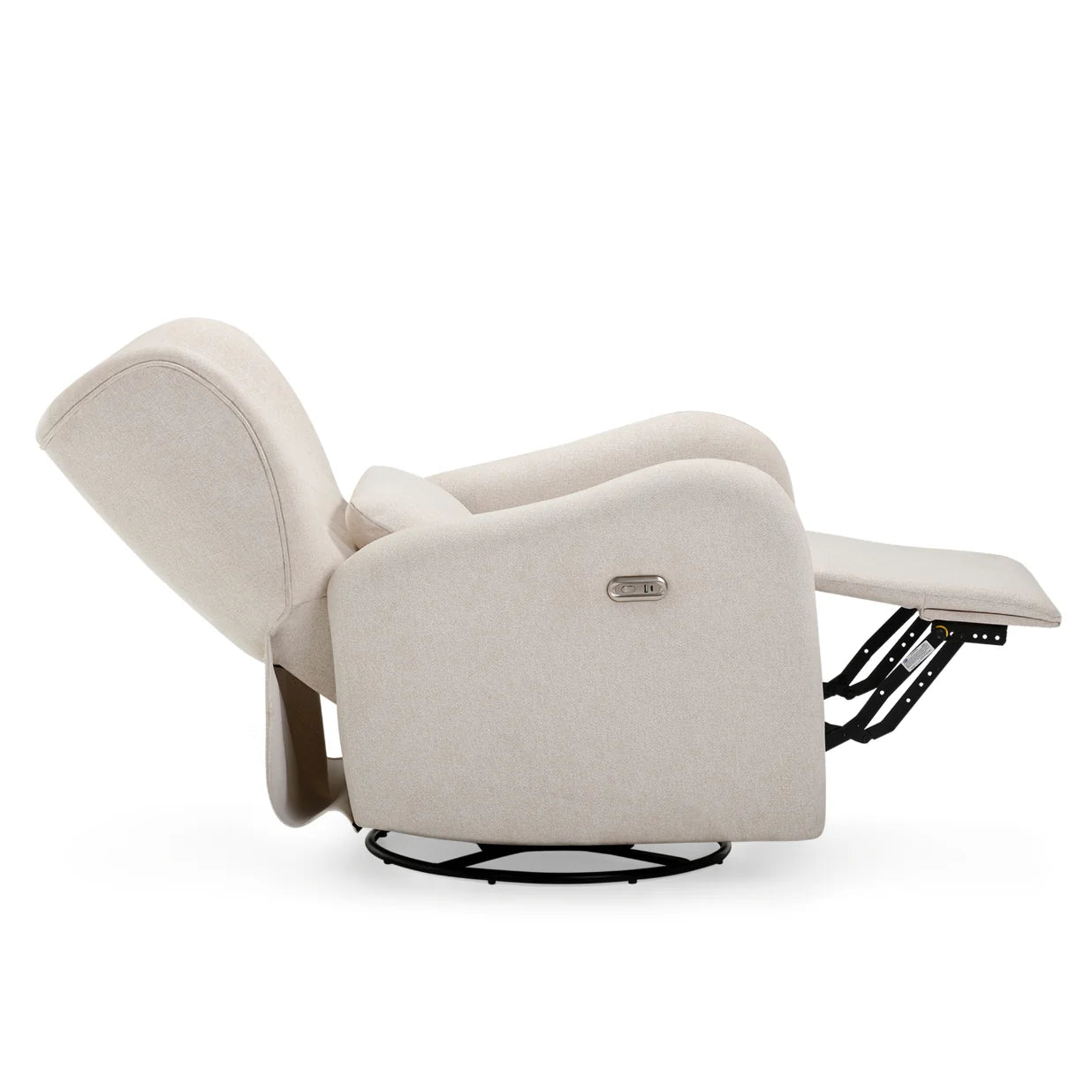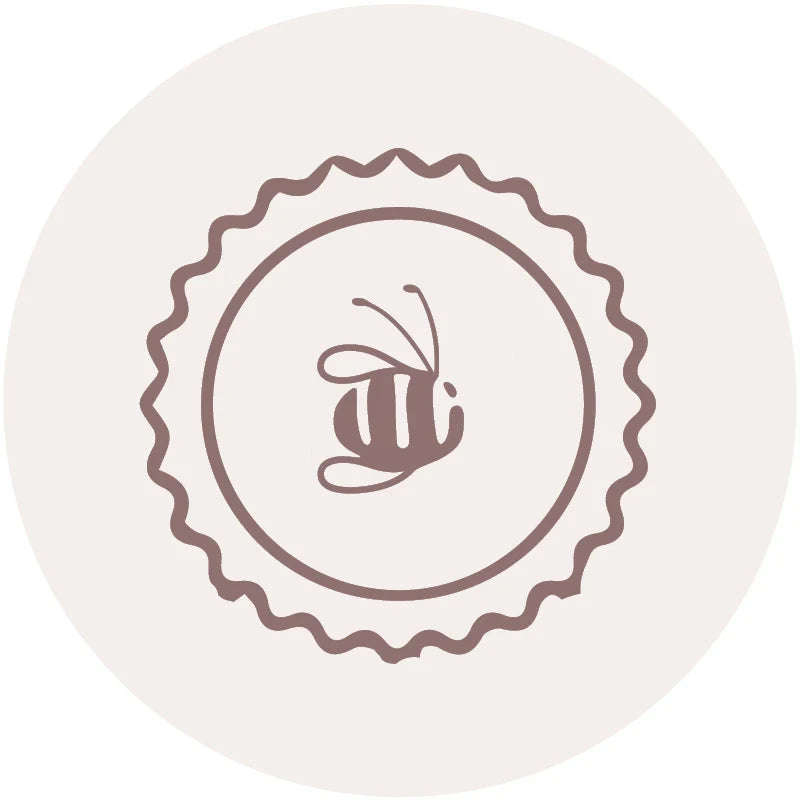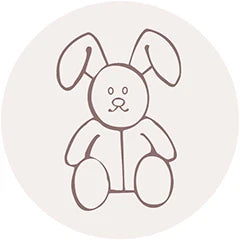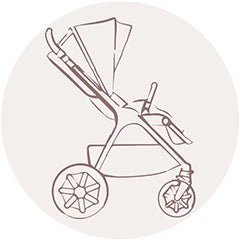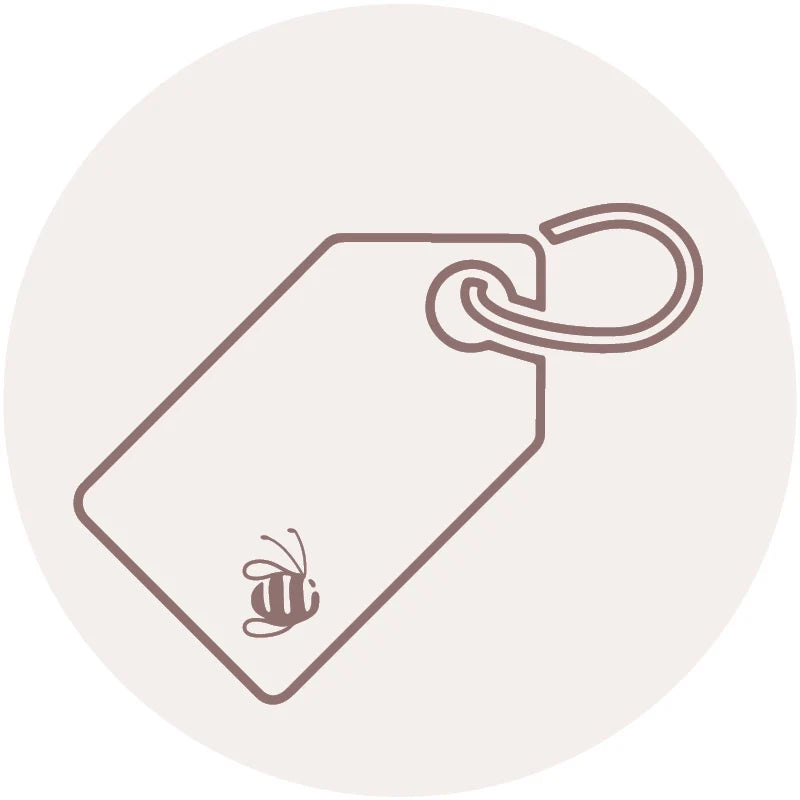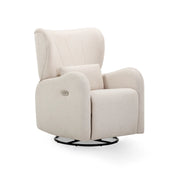Celeste Electric Nursery Chair
Celeste Electric Nursery Chair
SKU:ABF-NC-CE/WM
Clothing Prem to 18 Months
| Size | Age Guide | Weight | Height |
|---|---|---|---|
| Premature | Premature or Small Newborn | Up to 4Kg | Up to 55cm |
| Newborn | 0-3 months | 4-6Kg | Up to 62cm |
| 3 Month | 3-6 months | 6-8Kg | Up to 68cm |
| 6 Month | 6-12 Month | 8-10Kg | Up to 76cm |
| 12 Month | 12-18 Month | 10-12Kg | Up to 84cm |
| 18 Month | 18-24 Month | 12-14Kg | Up to 92cm |
Clothing 2 to 6 Years
| Size | Age Guide | Height | Chest | Waist | Hip |
|---|---|---|---|---|---|
| 2 Year | 2-3 Years | Up to 100 cm | 56 | 51 | 58 |
| 3 Year | 3-4 Years | Up to 105 cm | 58 | 53 | 60 |
| 4 Year | 4-5 Years | Up to 110 cm | 60 | 55 | 62 |
| 5 Year | 5-6 Years | Up to 115 cm | 62 | 57 | 64 |
| 6 Year | 6-7 Years | Up to 120 cm | 64 | 59 | 66 |
Beanie Size Guide
| Size | Head Circumference | Age Guide |
|---|---|---|
| Premature | 31-35 cm | Premature or Small Newborn |
| Newborn | 35-40 cm | Newborn |
| Small | 40-43 cm | 3-6 Months |
| Medium | 43-47 cm | 6-18 Months |
| Large | 47-52 cm | 18-3 Years |
Sunhat Size Guide
| Size | Head Circumference | Age Guide |
|---|---|---|
| Newborn | 37-40 cm | Newborn |
| Small | 40-43 cm | 3-6 Months |
| Medium | 43-46 cm | 6-12 Months |
| Large | 46-49 cm | 12-24 Months |
| Xtra Large | 49-54 cm | 2-4 Years |
Sleep Pods Size Guide
| Size | Weight | Age Guide | Measurement(Back to Hem) |
|---|---|---|---|
| Newborn | 0-6 kgs | 0-3 Months | 60.5 cm |
| Small | 0-8 kgs | 3-6 Months | 66 cm |
Booties Size Guide
| Size | Age Guide |
|---|---|
| Newborn | 0-3 Months |
| Small | 3-6 Months |
| Medium | 6-12 Months |
| Large | 12-18 Months |
Pretty Brave Baby
| Foot Length (mm) | Insole Length (mm) | EU | UK | Age | INT |
|---|---|---|---|---|---|
| 95-104 | 110 | 16/17 | 2 | 0-6m | S |
| 104-114 | 118 | 18 | 3 | 6-12m | M |
| 114-123 | 127 | 19/20 | 4.5 | 12-18m | L |
| 123-137 | 142 | 21/22 | 5.5 | 16-22m | XL |
Pretty Brave 1st Walker
| Foot Length (mm) | Insole Length (mm) | EU | UK | Age |
|---|---|---|---|---|
| 114-120 | 125-128 | 19 | 3 | 1 yr |
| 120-126 | 132-135 | 20 | 3.5 | 1-2 yrs |
| 126-132 | 138.5-141.5 | 21 | 4.5 | 1-2 yrs |
| 132-138 | 145-148.5 | 22 | 5 | 2 yrs |
Crywolf Swim Nappy
| Size | Length (waist to crotch) | Crotch Width (side to side) |
|---|---|---|
| 0-1 yr | 1-2 yrs | |
| 37 | 38 | |
| 14.5 | 15.5 |
Crywolf Rash Suit
| Size | Length (back neck to crotch) | Chest (arm to arm) | Waist (side to side) | Sleeve (neck to cuff) | Neck Opening(diameter) |
|---|---|---|---|---|---|
| 6-12 Months | 1 yr | 2 yrs | 3 yrs | ||
| 40 | 42 | 44 | 46 | ||
| 25 | 26 | 27 | 28 | ||
| 24 | 25 | 26 | 27 | ||
| 30 | 31.5 | 33 | 34.5 | ||
| 13.25 | 13.25 | 13.8 | 14.3 |
In stock
Couldn't load pickup availability
Overview
Overview
The Chair That Holds You Like a Hug
This is more than a rocking chair – it’s the embrace every parent-to-be longs for, and the unwavering comfort they didn’t know they needed. A hug in a chair.
Thoughtfully designed for the journey from bump to baby and beyond, the BabyRest Celeste Nursing Chair wraps you in comfort from the moment you sit down.
The cloud-soft headrest cradles your head and neck like the world’s gentlest hug because your rest matters too. Whether you're feeding at midnight or sneaking in a rare moment of calm, it’s your space to exhale.
The ergonomically sculpted armrests are perfectly positioned to support both you and baby – relieving tension in your shoulders and arms so you can feed, soothe, and snuggle in total comfort. It’s like the chair knows what you need before you do.
When your body is healing, every movement matters. That’s why we’ve designed a one-action recline feature, so the backrest and leg rest move smoothly, together, with a single motion. No pushing, no shifting, no awkward adjustments. Just thoughtful design for seamless support postpartum and relaxation at the touch of a button.
And because comfort should never come with compromise, we’ve included a premium cushion, meaning more ways to sink in and relax with baby.
The longer 3.4m power cord gives you more freedom to place your chair where it works for you, not your nearest power outlet. It’s a small detail that makes a big difference. More flexibility, less fuss - and a little more space to reconnect, recharge, and rest.
Whisper quiet glide and premium fabric that looks as beautiful as it feels, allows Celeste to blend seamlessly into your home, and your life.
This isn’t just furniture. It’s a sanctuary.
What's Included
What's Included
Key Features
Key Features
Technical Specification
Technical Specification
User Guide
User Guide
Delivery and Returns
Delivery and Returns
- Delivery: Free within NZ on orders over $100 (excluding bulky items) or $8 standard shipping
- Returns: Accepted within 14 days of receipt with proof of purchase
- Some items are excluded from returns including sale items, hardware, car seats, prams, monitors and personal items - please click here for the full list.
Share this product
Recently Viewed Products
Related Blogs
Introducing a bedtime routine with your baby
The Power of a Bedtime Routine for Your BabySimple rhythms that lead to better sleep - for both of you In the early weeks with a newborn, life tends to move to a rhythm all on its own. Feeds, naps, cuddles, and nappy changes often blur into one another, and any sense of routine can feel a little out of reach. That’s completely normal! As your baby grows, you’ll notice more predictable patterns beginning to emerge. This is the perfect time to gently introduce a bedtime routine – a simple series of calming steps that helps your baby unwind and gives you both a peaceful finish to the day. Why bedtime routines matter Babies thrive on repetition. A consistent series of calming activities each evening helps regulate their body clock, encourages longer stretches of sleep, and creates a comforting rhythm to the day. Routines don’t just benefit sleep - they also nurture connection, ease overstimulation, and make bedtime feel less like a battle and more like a shared moment of calm. These rituals will evolve as your baby grows, but the sense of structure and predictability will continue to support their development well into childhood. When to begin You can begin easing into a bedtime routine from around six to eight weeks old - once your baby begins to show more consistent sleep and feeding patterns. This is also when they start to recognise daily cues, making it the perfect time to introduce a gentle ritual that helps them wind down. How to get started There’s no “perfect” routine - what works for one family might not suit another. The key is consistency, calmness, and keeping things relatively short (20 to 30 minutes is ideal). Try to carry out most of the routine in your baby’s room so they start to associate the space with sleep. Here’s a sample rhythm to get you started: Bath - A warm bath helps wash away the day and begins the wind-down process. This can also be a fun and playful moment, especially if older siblings are involved. Massage - After bath time, a quick massage with something like Scullys Baby Massage Oil can help your baby get ready for rest. This is a wonderful way to connect with your baby through touch, as well as being very relaxing for both of you. Sleepwear - Soft, breathable pyjamas or a sleeping gown signal that bedtime is near. You might like to use Merino to help regulate temperature throughout the night. We have a gorgeous range of safe and cosy sleepwear available here. Feeding - Try offering the final feed early in the routine rather than just before sleep. This can help reduce reliance on feeding to fall asleep. Story or song - A simple board book, soft lullaby, or even humming a tune gives your baby a consistent cue that bedtime is here. It also builds language skills and creates special bonding moments. Cuddles - A warm snuggle and quiet kiss goodnight helps your baby feel safe, even if you’ll likely see them again overnight. Watch for sleepy cues Rather than watching the clock, keep an eye on your baby. Rubbing eyes, zoning out, yawning, or fussing can all signal tiredness. Aim to start the bedtime routine before they become overtired. For most babies, somewhere between 6:30 and 7:30 pm works well, and this timing can continue into the early school years. Keep the environment sleep-friendly A dark, quiet space tells your baby’s brain that it’s time to sleep. Avoid bright lights, noisy toys, or too much stimulation. Night lights can be helpful for feeding and changes, but aren’t necessary for sleep - babies aren’t born afraid of the dark. You could add a soft and practical sleep sound machine, like a Yogasleep Nod to make night-time care easier with it's built in night light. Put baby to bed drowsy, not asleep As you get to know your baby’s cues, try placing them into bed when they’re sleepy but still awake. This helps them learn to settle themselves, which can make overnight waking easier to manage. It also reduces the shock of waking up in a different spot from where they fell asleep. Be consistent - but stay flexible Consistency is key, but so is flexibility. There’ll be times when travel, illness, or overtired evenings throw things off. The idea is to have a calming, repeatable routine you can come back to, wherever you are. If more than one caregiver can do bedtime, that helps too - it builds flexibility and avoids babies becoming dependent on one specific parent for settling. Small rituals with lasting benefits Your baby’s routine doesn’t need to be perfect, and it will change over time. But these small, daily rhythms bring more than just sleep - they offer connection, confidence, and a peaceful way to end the day together. One day, your baby will be reading their own book at bedtime. But your cuddle and goodnight kiss? That will still matter, even if you have to sneak it in after lights out ❤️
Learn moreBreastfeeding Basics and Tips
Understanding the Fundamentals of Breastfeeding Breastfeeding might seem straightforward, but many new moms find it challenging. Patience is essential, and being well-prepared can make the process smoother. Here, we break down the basics to help you get ready for this journey. The Three Stages of Breast Milk Colostrum: The First Stage When your baby is born, your body produces colostrum, a clear or yellowish liquid packed with nutrients, proteins, and vitamins. This small amount is perfect for newborns, helping to protect their digestive tract and immune system. Transitional Milk: The Second Stage Regular breastfeeding will stimulate the production of transitional milk, which appears around the third to fifth day. It looks like a mix of milk and orange juice, rich in lactose, fat, and calories. Mature Milk: The Third Stage By the second week, mature milk replaces transitional milk. This pale, sometimes bluish milk provides all the nutrients, fat, and proteins your baby needs, adjusting its water content in hot weather and boosting antibodies when needed. Achieving a Good Latch Proper latching is crucial to prevent discomfort. A good latch covers both the nipple and the areola and shouldn't be painful. Here’s how to ensure a successful latch: Positioning Your Baby Hold your baby tummy-to-tummy with your breasts, keeping their head aligned with their body. Mouth to Nipple Tickle your baby’s lips with your nipple or express a bit of milk to encourage the rooting reflex. When your baby opens wide, bring them to your breast. Ensuring Proper Attachment A proper latch involves the baby’s chin and nose touching your breast. If necessary, adjust the bottom lip to ensure it isn’t tucked in. Watch for a steady suck-swallow-breathe pattern. Trying Different Positions If you encounter difficulties, experiment with different breastfeeding positions like the football hold or side-lying. Consult a lactation consultant if needed. Maintaining Comfort and Milk Supply Relax and Feed on Demand Stay calm and relaxed to enhance milk production. Allow your baby to feed without time limits, ensuring one breast is fully drained before switching to the other. Recognizing Hunger Cues Signs of hunger include nuzzling your breasts, rooting, sucking on hands or clothing, and making lip-smacking noises. Crying is a late hunger cue. Feeding Frequency Newborns typically feed 8-12 times a day. Some may need to be woken up for feeds if they sleep for more than six hours. Patience and Persistence Breastfeeding takes time and practice. Be patient with yourself and your baby, seeking professional help if needed. With time, breastfeeding will become more natural and enjoyable for both of you. By following these tips, you can create a calm and successful breastfeeding experience, eventually making it look effortless.
Learn moreMotherhood: Beyond the Fourth Trimester
Beyond The Fourth Trimester - A Sustainable Approach To Health Once the first few months with your new baby have passed you might be feeling like the haze of those early weeks has passed. You also might not be there just yet, just as each baby is different so is each pregnancy and the subsequent postpartum period. This is why it is important to be mindful of not judging how well you are doing based on other mothers who might appear to be completely back to normal with a baby who sleeps all night. If you are still breastfeeding, many mothers report a drop in milk supply at this point often saying that they no longer feel like their breasts are as full. This is something I experienced with my first baby and thought it meant I was losing my milk supply. It is normal for the initial fullness and engorgement to diminish as your milk supply is more established at this point, and your body has adjusted to supplying what your baby needs. If you do ever feel concerned by this your Plunket nurse, local lactation consultant or the La Leche league are a wonderful source of support & encouragement. Once those exhausting early months have passed many of the mothers I work with are keen to start focusing on reclaiming their pre-pregnancy bodies and to start dieting and exercising. Focusing on good nutrition and consistent exercise is hugely beneficial and has many positive health impacts such as increased energy, better sleep, improved mood and changes in body composition. What is really important to be mindful of, is that changes in diet and physical activity are best to be done with an incremental approach to minimise the chances of under-fuelling yourself, drops in milk supply, injuries and adding too much pressure on yourself. It also allows you to build sustainable health habits that you are more likely to maintain long term. I always recommend an appointment with a postpartum trained physiotherapist. They can assess your posture for diastasis recti (tummy muscle separation) and guidance on pelvic floor exercises. Women who have had caesareans often think because they haven't had a natural birth they don't need to worry about pelvic floor exercises - this isn't the case, pregnancy still takes its toll on the body so re-strengthening the pelvic floor after carrying a baby is important for all mothers. Working with a personal trainer that specialises in postpartum exercise is a great idea. They can ensure your exercise technique is correct to avoid injury and set an exercise program that is suitable for your current fitness level that will be mindful of the changes that need to be made to a fitness program based on your requirements postpartum. When looking at dieting I always encourage my Mum’s take a non-diet approach to focus on improving health not through restriction but with healthy nutritional choices that improve their health status not diminish it. To achieve this we focus on a nutritional approach that has a strong focus on nutrient repletion to help the body to replete nutrients that were preferentially supplied to their growing baby. Focusing on a diet full of whole unprocessed foods is the foundation for this. Most women find that this approach is very empowering, it leads to better satiety and self-regulation of eating over restriction then binge eating. When it comes to improving your diet always aim for progress, not perfection, and most importantly enjoy your meals! Adequate protein intake is essential for tissue repair and rebuilding especially when exercising. Sources of protein include meat, chicken, seafood, eggs, legumes nuts and seeds. Protein also helps to keep you feeling full for longer. I use and recommend Clean Lean Protein powder for smoothies as it is perfectly safe for breastfeeding mums. You can use the discount code ‘mela’ to save 15% at nuzest.co.nz . Eating plenty of colourful vegetables and some fruits (eat the rainbow!) is important to supply essential vitamins, minerals, phytonutrients, fibre and carbohydrate. I aim to have three fist-sized servings of vegetables with lunch and dinner. It is important to supply yourself with some complex carbohydrate for energy and to assist with glycogen repletion after exercising. Some good sources are pumpkin, yams, kumara, and whole grains such as brown rice and quinoa. Don't forget to incorporate healthy fats with each meal. Fats have been demonised and avoided for so long that many people are not aware of how important adequate fat intake is for health. Dietary fat is essential for the absorption of many nutrients, production of certain hormones, the supply of energy and support of cell growth. Good sources of healthy fats include oily fish such as salmon, extra virgin olive oil, hemp seed oil, avocado, nuts and seeds. Lastly don't forget to drink your water! Aim for two glasses on rising then another 2 litres throughout the day and more when exercising. If you are a breastfeeding mum aiming to have a glass of water with each feed I find keeping a water bottle close by during the day and for those night feeds is a great idea - it’s thirsty work! Kylie Stowe @melawholefoods Postpartum Nourish Bowl Serves 1 Ingredients 120-150 grams of cooked sliced meat (or vegetarian alternative) 2 cups of salad greens 1 cup of an assortment of diced colourful vegetables 1 palm-sized serve of cooked complex carbohydrate (pumpkin, yams, brown rice, quinoa, kumara) ¼ - ½ of an avocado or 40 grams of Feta 1 tbsp of hummus 1tbsp toasted pumpkin & sunflower seeds 2 tbsp of dressing of your choice. Method Arrange all of the ingredients in a bowl, season, drizzle with dressing and enjoy! My favourite dressing is made with extra virgin olive oil, apple cider vinegar & wholegrain mustard. To change up the flavours you can coat your protein in different herbs and spices the one pictured is Moroccan chicken.
Learn morePregnancy Pillows: Comfort for You, Your Bump & Beyond
During pregnancy, your body undergoes amazing changes to nurture and make space for your little one. As your pregnancy progresses, you may find it more challenging to get comfortable and restful sleep in preparation for the busy days ahead with your newborn. Weight gain during pregnancy can also put a strain on your joints, causing discomfort in your back, hips, knees, and ankles, making finding a comfortable position even harder. This is where a good pregnancy pillow becomes your best friend, offering the support you need to sleep more soundly and comfortably. Embrace Versatility with the 3-in-1 Buddy Supportive Pregnancy Pillow The Doomoo Buddy pillow offers full-body support, designed to relieve pressure on your hips and spine, whether you prefer sleeping on your side or your back. Its hypoallergenic micro pearl filling adjusts to your body’s shape, providing comfort throughout the night. But it’s not just for pregnancy! Once baby arrives, the Buddy becomes an excellent support for breastfeeding or bottle feeding, making those moments a bit more comfortable. It also serves as a soft cushion for your baby to rest or play on, making it a truly versatile product. For Extra Comfort: Doomoo Comfy Big & Doomoo Maxxy The Doomoo Comfy Big is designed for ultimate relaxation during pregnancy, with soft, supportive filling that allows you to find the perfect position for sleep or lounging. Whether you're supporting your growing bump or using it for added back support, the Comfy Big offers tailored comfort that adjusts to your body’s needs. The Doomoo Maxxy offers a versatile solution for both you and your baby. It’s perfect for sleeping, feeding, or even giving your baby a comfy place to rest and play. Its larger design makes it ideal for more support as your body changes during pregnancy, and it’s just as useful post-pregnancy when baby arrives. For feeding your little one Finally, the Doomoo Soft Feeding Pillow is a must-have for any new parent. Its soft, supportive design provides comfort during breastfeeding and ensures your little one is well-supported while feeding or relaxing. It can also double as a tummy time tool to help prop your baby up, or even a barrier for when they are learning to sit up on their own! We Love Doomoo! Softness and comfort are at the heart of everything Belgium-made brand Doomoo creates. Their products are designed with both you and your baby in mind, providing the perfect balance of support and relaxation. We love them for their thoughtful, high-quality designs that make pregnancy and postpartum life that much easier and more comfortable. They have a fantastic range of products designed to support both your and your baby’s sleep. Check out the full range here or visit us in-store at Dimples.
Learn more

